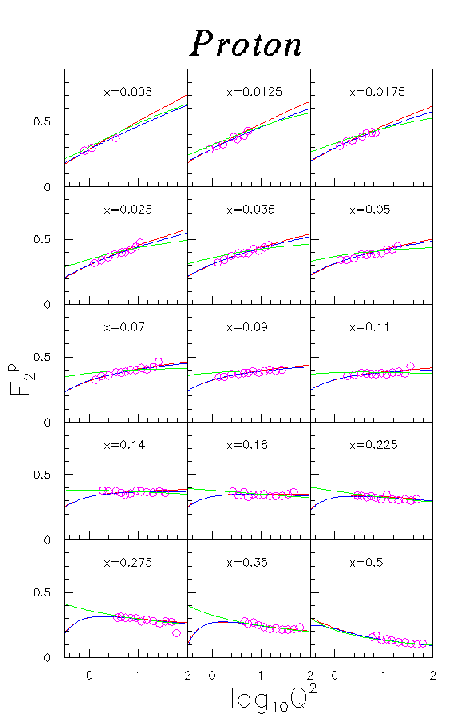 . In next paper [11], they used
. In next paper [11], they used  (eventual as same as
(eventual as same as  ) data from
ref.[1]. E130 used
) data from
ref.[1]. E130 used  evaluated at
evaluated at  GeV of
ref.[2].
GeV of
ref.[2].



In the first paper of E80 [10], they showed an asymmetry only
and did not extract  . In next paper [11], they used
. In next paper [11], they used  (eventual as same as
(eventual as same as  ) data from
ref.[1]. E130 used
) data from
ref.[1]. E130 used  evaluated at
evaluated at  GeV of
ref.[2].
GeV of
ref.[2].
In EMC,  values are taken from EMC parameterization [3]
but corrected from the value R=0 assumed in that paper to the QCD
value of R. There were some inconsistency between their and others
parameterization. So, for the final number of the integral of
values are taken from EMC parameterization [3]
but corrected from the value R=0 assumed in that paper to the QCD
value of R. There were some inconsistency between their and others
parameterization. So, for the final number of the integral of  ,
EMC used an averaged
,
EMC used an averaged  from different sources.
from different sources.
Since 1993, NMC parameterization[4] has been widely used by
the all post-EMC experiments, except E142. E142 used SLAC  parameterization [5]. NMC fit is based on 15-parameter
function [6]:
parameterization [5]. NMC fit is based on 15-parameter
function [6]:
with
 GeV
GeV ,
,  GeV and
GeV and



The second term,
 , accounts
for the leading order perturbative
, accounts
for the leading order perturbative  evolution, whereas the third
one,
evolution, whereas the third
one,  , is mainly responsible for
non-perturbative
, is mainly responsible for
non-perturbative  dependence.
dependence.
NMC fitted their data together with those of SLAC [5] and BCDMS [8] to obtain parameters listed in Table. ii. They found that EMC data show clear differences compared with the others.

Table ii: The values of the parameters of eq. (40)
for  and
and  .
.
In 1995, NMC published a new set of parameters [7] which supersedes their previous analysis [4]. New parameters are also listed in Table ii. They compared their results with E665 (FNAL DIS experiment using 490 GeV muon) or HERA and found good agreements.
It is possible to build  from the set of parton distribution
function.
However, most of PDF sets start minimum
from the set of parton distribution
function.
However, most of PDF sets start minimum  or 5 GeV, which
means they cannot cover a part of polarized DIS experiment data region.
Fig.5 shows new and old NMC parameterization and
or 5 GeV, which
means they cannot cover a part of polarized DIS experiment data region.
Fig.5 shows new and old NMC parameterization and  from GRV94LO[9] together with NMC data. The parameterization
GRV94 given by dynamical approach requires valence and
valence-like input and valence-like gluon and sea input
distributions. For the former, they used
from GRV94LO[9] together with NMC data. The parameterization
GRV94 given by dynamical approach requires valence and
valence-like input and valence-like gluon and sea input
distributions. For the former, they used  within
within  for the latter, previous NMC, BCDMS and SLAC
for the latter, previous NMC, BCDMS and SLAC  data at
data at  and
and  GeV
GeV are used. The gluon
distribution at larger
are used. The gluon
distribution at larger  is constrained by the
direct-photon. These parameter are also constrained by the energy
momentum conservation.
is constrained by the
direct-photon. These parameter are also constrained by the energy
momentum conservation.
Although there are small differences between old and new
parameterizations at first three x-bin in high  region,
the parameterization has the same amount of uncertainties at that
region. Then, those are not significant.
region,
the parameterization has the same amount of uncertainties at that
region. Then, those are not significant.
There is a good agreement between the NMC parameterization and GRV94LO
in general. However, one can see a little discrepancy at low  and
and
 range, where NMC data still exist.
The situation seems not to be improved even if one uses NLO fit
[9]. Since there are a lot of p-DIS data in this region, the
NMC phenomenological fit seem to be suitable for our purpose.
range, where NMC data still exist.
The situation seems not to be improved even if one uses NLO fit
[9]. Since there are a lot of p-DIS data in this region, the
NMC phenomenological fit seem to be suitable for our purpose.

Figure 5: NMC  parameterization (red is newer and blue is older
one) together wit GRV94LO (green) and NMC data points.
parameterization (red is newer and blue is older
one) together wit GRV94LO (green) and NMC data points.


